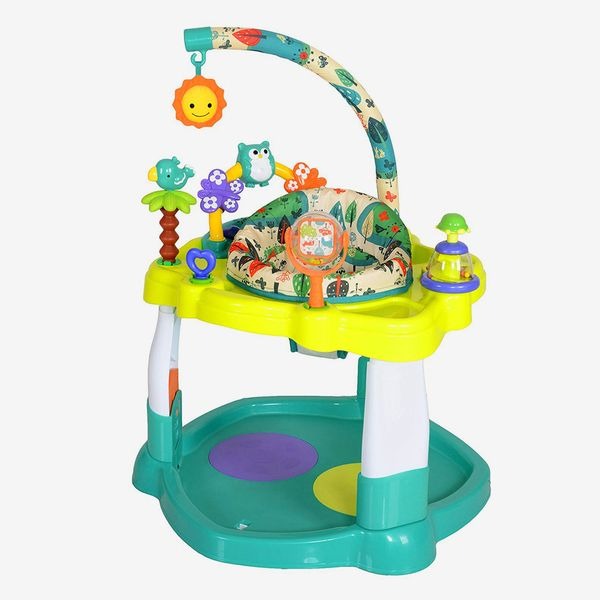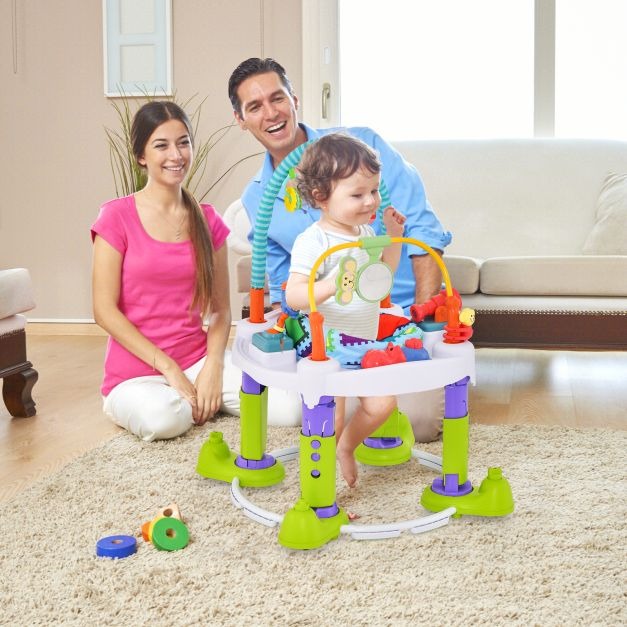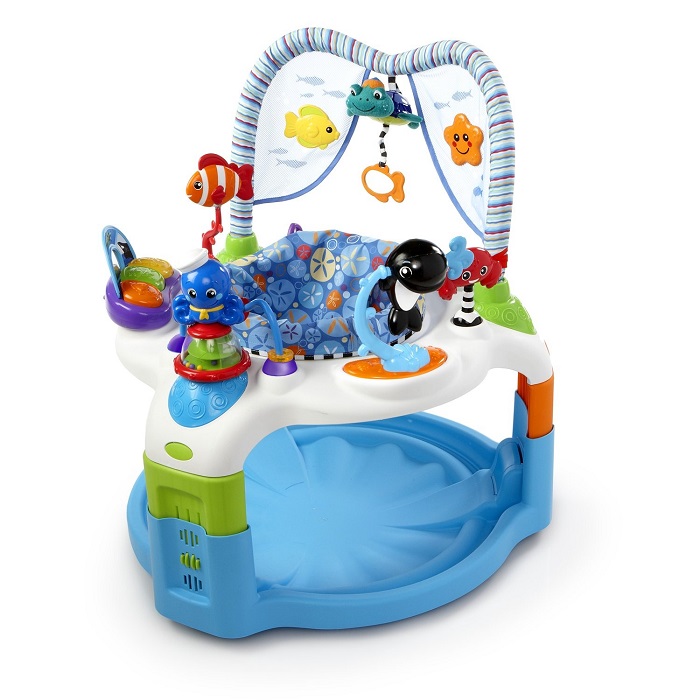Introduction to Baby Saucer Walkers
Baby saucer walkers are popular among parents who wish to support their little ones as they learn to walk. These devices come with a base, wheels, and a suspended seat. They allow infants to stand and move around before they’ve mastered walking. The right baby saucer walker offers fun and stimulation. It also encourages the development of motor skills in a secure environment.
The Evolution of Baby Walkers over the Years
Baby walkers have changed a lot over time. Early designs were simple and often unsafe. Modern baby saucer walkers value safety much higher. Today’s models feature advanced materials and safety mechanisms. They adapt to different baby sizes and room layouts. The best baby saucer walkers now offer much more than mobility. They provide interactive toys, music, and learning activities. These features engage and entertain babies while helping them grow and explore safely.
Essential Safety Features in Modern Baby Saucer Walkers
In 2025, when selecting a baby saucer walker, safety is paramount. Modern baby saucer walkers are designed with a range of essential features to protect infants as they explore and learn to walk. These features help mitigate risks, ensuring the baby’s first steps are taken in a secure environment.
Adjustability and Stability
Adjustability in a baby saucer walker allows for a customized fit, catering to the baby’s growing body. Look for walkers that offer adjustable height settings. This ensures that the baby’s feet can touch the ground comfortably, aiding in proper development. Stability is crucial for preventing tipping incidents. A broad, sturdy base is a must; it keeps the walker upright even when baby moves vigorously. Saucer walkers with a non-slip base also add an extra layer of safety.
Materials and Construction
The materials used in constructing a baby saucer walker should be non-toxic and durable. BPA-free plastics and metals without sharp edges are advisable for a baby’s health and safety. The construction should be robust, capable of withstanding the weight and movement of an active baby. Besides, the walker should have secure, easy-to-clasp buckles and straps. This ensures the baby stays safely in place while maneuvering their saucer walker.
Pros and Cons of Using a Baby Saucer Walker

Like any child development tool, a baby saucer walker comes with its own set of advantages and disadvantages. As parents, it’s crucial to weigh these factors to make informed decisions that best suit your child’s needs.
Pros:
- Engagement: Baby saucer walkers offer a variety of interactive toys and activities that can keep infants entertained.
- Mobility: These walkers enable babies to move around and explore their surroundings, which can be thrilling for them.
- Motor Skills: Moving in a walker can help babies develop their leg muscles and coordination, contributing to motor skill development.
Cons:
- Overdependence: There’s a risk that babies may become too reliant on baby saucer walkers, possibly delaying natural walking development.
- Safety Concerns: If not used correctly, baby saucer walkers can lead to accidents, like tipping over or descending stairs.
- Space Requirements: Baby saucer walkers need ample space to be used safely, which can be a challenge in smaller homes.
Developmental Considerations
When evaluating the use of a baby saucer walker, developmental implications are significant. Infants must have the opportunity to learn to walk naturally, which involves crawling, standing, and balancing without assistance.
- Muscle Development: While walker use can assist in building leg muscles, it’s important that babies also have time to develop their torso and arm muscles, which can be overlooked when in a walker.
- Crawling Importance: Crawling plays a vital role in developing cross-body coordination and spatial awareness. Baby saucer walkers should not replace ample floor time for crawling.
- Natural Progression: Babies should be encouraged to progress towards walking at their own pace. Overuse of a walker can interfere with this natural progression.
Balanced use of a baby saucer walker, with careful consideration of these developmental aspects, is essential for a baby’s overall growth and well-being.
2025’s Top-Rated Baby Saucer Walkers
In 2025, the market offers various top-rated baby saucer walkers. These models stand out due to their advanced safety features, innovative designs, and the positive feedback from numerous parents. To help you decide, we’ve researched and compiled a list of the highest-rated baby saucer walkers this year. They excel in providing support, engagement, and safety for your baby. Remember, choosing a walker is about more than just ratings. Select one that fits your space and matches your baby’s needs.
Key Safety Certifications to Look For
When choosing the best baby saucer walker, safety certifications are a must. Look for products with approvals from recognized safety organizations. Certifications to seek include JPMA (Juvenile Products Manufacturers Association) or ASTM (American Society for Testing and Materials). These signify compliance with strict safety standards. A CPSC (Consumer Product Safety Commission) label means it meets U.S. federal safety regulations. Additionally, check for any recalls or safety notices related to the walker. By choosing a walker with these key certifications, you ensure an added layer of protection for your child.
User Guide: Setting up Your Baby Saucer Walker Safely

Once you’ve selected the right baby saucer walker, setting it up properly is essential. This setup process ensures safety and helps your baby gain the most benefit from their new walker.
Location and Supervision Guidelines
The location for your baby saucer walker matters. Choose a flat, open area free from hazards like stairs, pools, or heavy traffic. Make sure the space allows your baby to roam without bumping into furniture or walls. Avoid places near appliances or cords that could pose a danger.
Constant supervision is key when your baby is in the walker. Never leave them unattended. Always be within arm’s reach to prevent accidents or injuries. Providing close supervision ensures you can react quickly if your baby needs help or the walker needs adjusting.
By following these location and supervision guidelines, you can create a safe environment for your baby to explore and grow. Remember that while baby saucer walkers can provide fun and stimulate development, they are not a substitute for close parental interaction and vigilance.
Maintenance and Safety Checks for Long-Term Use
To ensure your baby saucer walker remains safe over time, routine maintenance and safety checks are crucial. Just like any baby gear, a baby saucer walker can suffer wear and tear. This can compromise its safety features. By implementing regular inspections, you maintain the walker’s integrity.
Regular Inspection Points
Here are key inspection points to keep in mind for maintaining your baby saucer walker:
- Wheels and Brakes: Check the wheels regularly for any damage or signs of excessive wear. Make sure the brakes function properly to prevent unwanted movement.
- Seat Integrity: Inspect the seat for any tears, fraying, or weak spots that could affect its sturdiness or your baby’s comfort.
- Locking Mechanisms: Ensure that all locking mechanisms are in good working order. They are essential for keeping the walker stable when in use.
- Cleanliness: Keep the walker clean, as build-up of dirt or spillages can lead to bacterial growth or cause moving parts to stick or malfunction.
- Toys and Attachments: Verify that all toys and attachments are secure and free from damage. Loose parts pose a choking hazard.
- Frame and Structure: Examine the frame for any signs of damage or stress, including cracks or bent parts that could weaken the walker.
By regularly checking these points, you prioritize your baby’s safety. This also helps to prolong the life of your baby saucer walker. It’s advisable to perform these checks at least once a month or as often as needed based on usage.
Alternatives to Baby Saucer Walkers

Sometimes, parents may seek alternatives to baby saucer walkers. It’s important to have safe options that also support infants’ development and mobility. Alternatives should offer stability and encourage natural progress in motor skills. They should also be free from the risk of accidents associated with baby saucer walkers.
Safe Mobility Options for Infants
Several safe mobility options can be considered for infants. Here are some alternatives to baby saucer walkers:
- Stationary Activity Centers: These provide a range of toys and activities without the mobility factor. They can prevent the risk of falls and are a secure place for play.
- Push Toys: Push toys can aid in building strength and balance as babies learn to walk. They allow infants to control the pace and provide physical support.
- Playpens: A playpen can offer a safe and confined space for babies to play and move freely. This helps build their muscles and coordination without the dangers of a walker.
- Floor Time: Simply allowing babies ample time on the floor can be essential for development. It encourages crawling, which is key for cross-body coordination and muscle growth.
- Assisted Walking: Holding an infant’s hands while they walk can be more beneficial. It directly supports their natural walking progress and can boost confidence.
When choosing an alternative, always consider the baby’s age, physical abilities, and individual needs. It’s also wise to consult with a pediatrician to understand what is suitable for your child’s growth. These alternatives, combined with careful supervision, can offer safer and more beneficial ways for your baby to explore movement and develop crucial motor skills.
Conclusion
Concluding our comprehensive safety review, it’s clear that baby saucer walkers can be valuable tools. They support infants as they learn to explore their surroundings. However, it’s crucial for parents to prioritize safety and informed decision-making when choosing and using these devices.
Final Thoughts on Baby Saucer Walker Safety
Selecting the right baby saucer walker involves looking at safety features, adjustability, and durability. Always opt for models with safety certifications, like those from JPMA or ASTM. Proper setup and regular maintenance can’t be overstated. It ensures the walker stays safe as your baby grows.
It’s also important to remember that walkers are just one part of baby’s development. Floor time, crawling, and assisted walking are necessary for balanced growth. Alternatives like stationary activity centers or push toys can offer safer means for development, minimizing walker-related risks.
In conclusion, while a baby saucer walker brings joy and mobility, safety comes first. With vigilant supervision and adherence to safety guidelines, these walkers can be a fun addition to your baby’s early adventures. Consider all aspects wisely to make the most beneficial choice for your little one’s developmental journey.